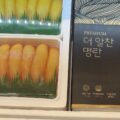Dalgona

South Korean Dalgona Took the World by Storm in 2020 and 2021
What started with the Dalgona Coffee trend on TikTok culminated in the appearance of this simple, sweet candy on the popular Netflix show Squid Game. Dalgona became famous worldwide, with many people recreating recipes and playing the dalgona game. But dalgona has actually been around for much longer in South Korea. How did this cheap street food, made literally from just sugar and baking soda, become so popular? Let’s find out!
What Is Dalgona?
Dalgona is a Korean street food made from just two ingredients: sugar and baking soda. The sugar is melted and mixed with a pinch of baking soda which releases carbon dioxide when heated. This causes the sugar to puff up, making the candy light, airy, and crunchy once cooled.
Typically, street vendors pour the caramel-colored liquid onto a flat surface and stamp it with molds shaped like stars, hearts, cars, or triangles. People try to break out the shape without cracking it—either by eating around it or breaking off small pieces. If successful, the vendor gives them another candy for free. Today, dalgona can be found everywhere in Korea, from street cafes to fine dining restaurants.
History of Dalgona
Dalgona has a long history in South Korea. Right after World War II, Korea was very poor. Many children had grown used to chocolates handed out by American soldiers, so street vendors made dalgona candy to fill the gap. When sugar was expensive, glucose was used instead. But by the 1960s, sugar became cheaper and easier to mold, so it replaced glucose.
In the 1970s and 1980s, dalgona vendors were common near schools, parks, and toy stores, as children loved both the candy and the game. However, dalgona’s popularity declined in the early 2000s due to foreign candies entering Korea, causing many vendors to go out of business. Luckily, the Dalgona Coffee trend and Squid Game’s success brought dalgona back into the spotlight.
Dalgona vs. Ppopgi
You may have seen the name ppopgi used interchangeably with dalgona. Technically, dalgona (달고나) refers to candies made with glucose, while ppopgi (뽑기) refers to those made with sugar. Since sugar-based candies became more popular, the term dalgona is now often used for both. Before mass media popularized “dalgona,” many regional names existed in the 1970s and 1980s.
Examples:
¤ Ttigi (띠기) in southwestern provinces
¤ Gukja (국자) in Daegu and North Gyeongsang (meaning ladle)
¤ Jjokja (쪽자) in South Gyeongsang
¤ Orittegi (오리떼기) in Masan
¤ Ttong-gwaja (똥과자, literally “poop cookie”) in Busan
¤ Ttegi (떼기) in Jeju dialect
Dalgona in Squid Game
Though dalgona became known internationally in 2020 thanks to the coffee trend, the candy itself went viral worldwide due to Squid Game. In the show, contestants must carefully cut out the shape on their dalgona without cracking it—losing means death. Some shapes, like triangles, are easier to remove. One contestant discovers a trick to win:
Spoiler alert: sugar softens with water! Licking the back of the candy slowly dissolves it, or heating a needle to trace the shape melts the lines, allowing perfect removal.
After the show aired, dalgona surged in popularity in Korea and worldwide. The #dalgonachallenge became a TikTok hit with many trying the candy and game. Fun fact: all dalgona candy in Squid Game was made by a traditional vendor who became so busy he couldn’t go home for a week!
Dalgona Coffee
Before the candy’s resurgence, dalgona was trending on TikTok in 2020 thanks to Dalgona Coffee—a whipped mixture of instant coffee, sugar, and water served over milk. This drink gained fame during the COVID-19 pandemic due to its calming, ASMR-like appeal.
Interestingly, Dalgona Coffee doesn’t contain any dalgona candy and didn’t originate in Korea. The name came when actor Jung Il-woo tasted the drink in Macau and compared it to dalgona candy, sparking the trend in Korea.



